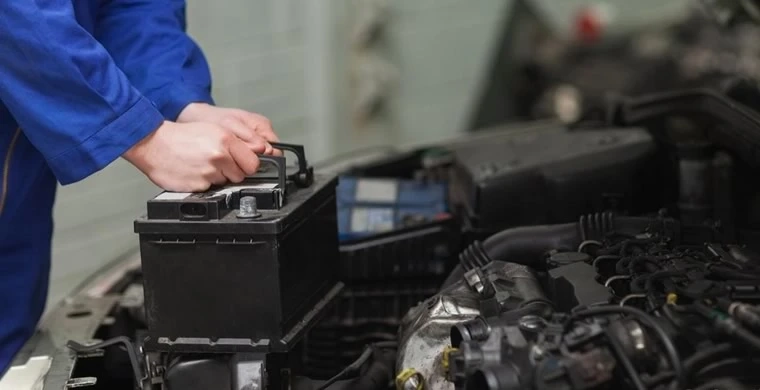Mastering Automotive Battery Replacement: A Guide for Peak Performance**
**Introduction**
In the intricate web of automotive maintenance, few components hold as much importance as the battery. Serving as the lifeblood of a vehicle's electrical system, the battery ignites the engine and powers vital electronic components. However, like all parts subject to wear and tear, batteries degrade over time, necessitating replacement. In this comprehensive guide, we embark on a journey to demystify automotive battery replacement, equipping you with the knowledge to optimize performance and extend the life of your vehicle.
**Understanding Automotive Batteries: Types and Functions**
:(Battery Replacements and Jump Starts)
Before delving into the replacement process, it's essential to grasp the basics of automotive batteries. Most vehicles rely on lead-acid batteries, available in two primary variants: flooded and sealed. Flooded batteries require occasional maintenance to replenish electrolyte levels, while sealed batteries offer convenience with their maintenance-free design.
Regardless of type, the primary function remains consistent: to store and deliver electrical energy to start the engine and power various electronic systems when the vehicle is not running. Understanding these fundamentals lays a solid foundation for effective battery replacement strategies.
**Signs of Battery Degradation: Knowing When to Replace**
Recognizing the signs of battery degradation is crucial for proactive maintenance and avoiding unexpected breakdowns. Here are some key indicators to watch out for:
1. **Diminished Cranking Power**:
If your engine cranks slowly or struggles to start, it's a clear signal of a weakening battery.
2. **Electrical Issues**:
Malfunctions in electrical components such as dimming headlights, flickering dashboard lights, or erratic behavior from electronic systems could indicate battery problems.
3. **Age**:
Most automotive batteries have a lifespan of 3 to 5 years. If your battery approaches or exceeds this timeframe, replacement may be imminent.
4. **Corrosion and Leakage**:
Visible corrosion on battery terminals or signs of electrolyte leakage suggest deterioration and potential failure.
**Selecting the Right Replacement Battery**
:(Battery Replacements and Jump Starts)
Choosing the appropriate replacement battery is crucial for optimal performance and compatibility with your vehicle. Consider the following factors:
1. **Battery Size and Type**:
Consult your vehicle's manual or a trusted mechanic to determine the correct battery size and type for your specific make and model.
2. **Cold Cranking Amps (CCA)**:
CCA measures a battery's ability to start the engine in cold temperatures. Choose a battery with a CCA rating suitable for your climate to ensure reliable cold-weather performance.
Reserve capacity indicates how long a battery can provide power in case of alternator failure. Opt for a battery with sufficient reserve capacity for your driving needs.
4. * Reputation and Warranty**:
Invest in batteries from reputable brands known for quality and reliability. Additionally, consider the warranty coverage offered to protect against defects and premature failure.
**Pre-Installation Preparation**
:(Battery Replacements and Jump Starts)
Before replacing the battery, take the following preparatory steps to ensure a smooth and safe installation process:
1. **Safety First**:
Wear appropriate protective gear, such as gloves and safety glasses, to shield yourself from battery acid.
2. **Disconnecting the Old Battery**:
Turn off the engine and all electrical components. Start by disconnecting the negative terminal followed by the positive terminal to prevent accidental short circuits.
3. **Inspecting Battery Tray and Terminals**:
Check the battery tray for corrosion or damage, and clean if necessary. Inspect the terminals for corrosion and clean them with a wire brush and terminal cleaner solution.
**Installation Procedure**
Follow these steps for proper installation of the new battery:
1. **Placing the New Battery**:
Carefully position the new battery in the battery tray, ensuring proper orientation with the terminals aligned correctly.
2. **Connecting Terminals**:
Attach the positive terminal first, followed by the negative terminal. Tighten the terminal clamps securely to prevent looseness.
3. **Applying Terminal Grease**:
Apply a thin coat of terminal grease to the battery terminals to inhibit corrosion and ensure good electrical conductivity.
4. **Securing Battery Hold-Down**:
If your vehicle is equipped with a battery hold-down, secure the new battery in place to prevent movement during vehicle operation.
**Post-Installation Checks and Maintenance**
:(Battery Replacements and Jump Starts)
After installing the new battery, perform the following checks to confirm proper operation and longevity:
1. **Starting the Engine**:
Start the engine and verify that it starts smoothly without any issues. Monitor for any abnormal sounds or warning lights.
2. **Electrical System Test**:
Test various electrical components, including headlights, turn signals, and the audio system, to ensure they function correctly.
3. **Charging System Inspection**:(Battery Replacements and Jump Starts)
Use a multimeter to check the voltage output of the alternator and ensure it is charging the battery within the recommended range.
4. **Regular Maintenance**:
Implement a regular maintenance schedule, including periodic inspection of battery terminals, cleaning, and testing to prolong battery life.
**Conclusion**
Automotive battery replacement is a critical aspect of vehicle maintenance that demands attention to detail and adherence to best practices. By understanding the signs of battery degradation, selecting the right replacement battery, and following proper installation and maintenance procedures, you can optimize performance and prolong the lifespan of your vehicle's electrical system. Remember, proactive maintenance is the key to preventing unexpected breakdowns and ensuring a smooth ride on the road ahead.



